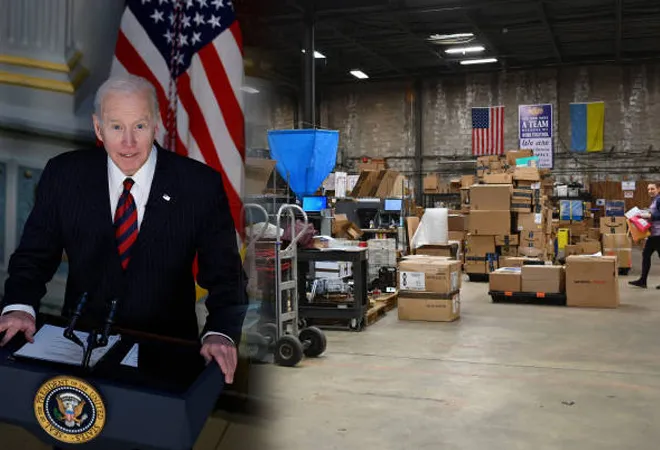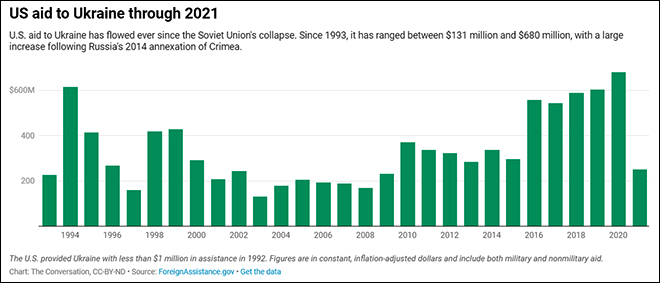
This brief is a part of
The Ukraine Crisis: Cause and Course of the Conflict.
The US role in assisting Ukraine has been front and centre ever since the USSR dissolved and Ukraine was left with the third
largest nuclear arsenal in 1991. However, the nature of US assistance to Ukraine has evolved in the face of changing threats and needs of Kyiv. While the US started helping Ukraine in the process of denuclearisation which continued until 1996, the nature of its assistance to Ukraine changed hues and became more political even as political instability hit Ukraine with contested elections culminating in the
Orange Revolution. Between 2004–05, the US provided US
$13.8 million to Ukraine towards “election-related assistance”. Since 2013–14, US assistance to Ukraine increased even more significantly in the wake of the
Euromaidan Revolution. The 2014 Russian annexation of Crimea further changed the course and scale of US assistance to Ukraine, primarily focused on weapons, training, and intelligence to fight militias in its east. Between 2015 and 2020, the US State Department and the USAID together
provided US $418 million every year on an average, apart from a US $350-million humanitarian aid since 2014. For 2021 alone, the US aid to Ukraine totalled US $464 million. The graph below gives a good measure of the increase in the US assistance to Ukraine. This year, however, seems to be leaving all the previous numbers behind.
 Source: https://www.thestreet.com/phildavis/news/us-aid-to-ukraine-13-6-billion-approved-following-russian-bombardment-marks-sharp-increase
Source: https://www.thestreet.com/phildavis/news/us-aid-to-ukraine-13-6-billion-approved-following-russian-bombardment-marks-sharp-increase
Aid to Ukraine during the crisis
In the current crisis, more than 30 countries have provided security assistance to Ukraine since its conflict with Russia. The US has led the efforts to provide Ukraine with economic, political, military, and other assistance. When the Biden administration ruled out a direct confrontation with Russia, it became clear that support through aid and assistance would be the mainstay of western support to Ukraine in the face of Russian aggression. Ukraine’s political position outside the NATO augmented the challenges for the NATO members to extend support to Ukraine, especially on the back of Russian threats that supply lines to Ukraine could become easy targets for Russian military forces. The US has led from the front in lending support to Ukraine because of various reasons. First, as the leading superpower of the ‘free world’, a champion of the liberal order, a European ally and most of all as a strategic opponent of Russia, it behoved the US to support a besieged country surrounded by a much larger power. Second, sending aid allowed the US to stay away from a direct war with Russia. Third, a collective mobilisation of resources through NATO for Ukraine rekindled the strategic purpose of NATO and showcased American leadership at the time of crisis. It may be a different note that many see the resultant trans-Atlantic solidarity between Europe and the US having come at the cost of peace and stability in Ukraine. Beyond the resurgence of the trans-Atlantic alliance, the immediacy and seriousness of the threat on Ukraine has brought to bear an unprecedented institutional agility in the US, galvanised by the purpose of aid delivery mechanisms. For instance, the Pentagon has
claimed that the aid delivery to Ukraine from the US has “never been done that fast before”.
Ukraine’s political position outside the NATO augmented the challenges for the NATO members to extend support to Ukraine, especially on the back of Russian threats that supply lines to Ukraine could become easy targets for Russian military forces.
The US has
committed more than US$2 billion to Ukrainian aid since the start of the Biden administration. Out of this, at least US $1 billion was provided in March alone this year. This included US $800 million in security assistance to Ukraine in the form of the following equipment: 800 Stinger anti-aircraft systems; 2,000 Javelin; 1,000 light anti-armour weapons, and 6,000 AT-4 anti-armour systems;100 Tactical Unmanned Aerial Systems; 100 grenade launchers, 5,000 rifles, 1,000 pistols, 400 machine guns, and 400 shotguns; Over 20 million rounds of small arms ammunition and grenade launcher and mortar rounds; 25,000 sets of body armour; and 25,000 helmets.
Amongst other important weapon systems
supplied by the US to Ukraine are five Mi-17 helicopters, three patrol boats, four counter-artillery and counter-unmanned aerial system tracking radars, 70 High Mobility Multipurpose Wheeled Vehicles (HMMWVs), secure communications, electronic warfare detection systems, Satellite imagery and analysis capability etc. Other forms of aid include helping the refugees, providing training to Ukrainian military personnel and help in the form of defence equipment.
The legislative ground for US help to Ukraine is enshrined in the
Ukraine Supplemental Appropriations Act, 2022, which promises to provide US $13.6 billion in emergency funding to support Ukraine. Broadly, this funding is divided into other fields: US$100 million for Food for Peace grants to support in-kind agricultural commodity donations for food assistance to Ukraine and Ukrainian refugees; US$22.1 million to support economic and trade-based analysis, enforcement, and coordination with partners on Russian and American vulnerabilities related to global trade and export ramifications of the conflict in Ukraine; US $59.4 million disbursed through the Department of Justice (DOJ) for National Security Division to support DOJ Ukraine Task Force work on export control, sanctions, and cyber cases related to the conflict. Besides, the funding includes US $6.528 billion through the Department of Defense for the strengthening the European Command operations and replenishing equipment stock sent to Ukraine.
US $59.4 million disbursed through the Department of Justice (DOJ) for National Security Division to support DOJ Ukraine Task Force work on export control, sanctions, and cyber cases related to the conflict.
Almost all departments have
come together to send support for Ukraine. The Department of Energy has pledged US $30 million; the Department of the Treasury—US $61 million; the Department of State—US $3.972 billion and US $2.795 billion through the US Agency for International Development (USAID) including US $2.65 billion for International Disaster Assistance to provide emergency food assistance, healthcare, and urgent support for vulnerable populations, and communities inside Ukraine and in the region.
In the light of these numbers and coming together of most institutional machineries of the US government like never before, it is also important to assess the scale, purpose, and achievements of US assistance to Ukraine. Even though the US continues to send aid to Ukraine and continues to impose sanctions, an assessment of its aid to Ukraine may put in perspective the effectiveness of the US strategy to achieve coercive diplomacy abroad with Russia and political success at home by supporting Ukraine. All, while itself staying away from any direct military confrontation.
Deepening doubt?
The US aid to Ukraine in the face of Russian aggression, primarily security assistance, has definitely bolstered the
readiness, command and control, and situational awareness of Ukrainian forces through both non-lethal and lethal defensive items. Combined with assistance from other countries from Europe, and some countries in Asia like Australia, it has been able to stall the advance of Russian forces westward and even forced a retreat to the eastern side of the country. However, despite this mind-boggling numbers, there is deep scepticism over the political success of US strategy of sending aid to the Ukrainians. While some see the aid to Ukraine as an alibi to stay away from a direct conflict, others see it as the actual reason that pushed Ukraine into a conflict with Russia. Besides, providing security aid stands quite in contrast with actual security commitments between countries, with one unable to replace the other. In times of war, where immediacy and deliverance matters more than ever, security aid don’t just have their own limitations but become one of the most vulnerable target nodes for the enemy. The US has no formal security umbrella that extends security to the Ukrainians—conventional or nuclear. With Ukraine expected to remain outside NATO, US aid to Kyiv is likely to have continued limitations. Although, as a result of unprecedented US aid to Ukraine some unintended goals such as inter-departmental coordination and lessening red-tape within the US and, a resurgence of NATO may be achieved as some of the unintended consequences.
Under continued assessments that Russia might regroup for another attack on Ukrainian cities, the West led by the US is once again planning to increase assistance to Ukraine. While a combined aid to Ukraine may have prevented a Russian run-over of Kyiv, a prolonged war in Ukraine may impact President Biden’s ability to convince the Congress of supporting the war in Ukraine. For now, Biden has
signed a funding bill to keep the government running through September and to send US $13.6 billion in aid to Ukraine. However, he faces the vagaries of the evolving war on the outside and the upcoming midterm elections inside the country.
The views expressed above belong to the author(s). ORF research and analyses now available on Telegram! Click here to access our curated content — blogs, longforms and interviews.



 This brief is a part of
This brief is a part of 
 PREV
PREV


